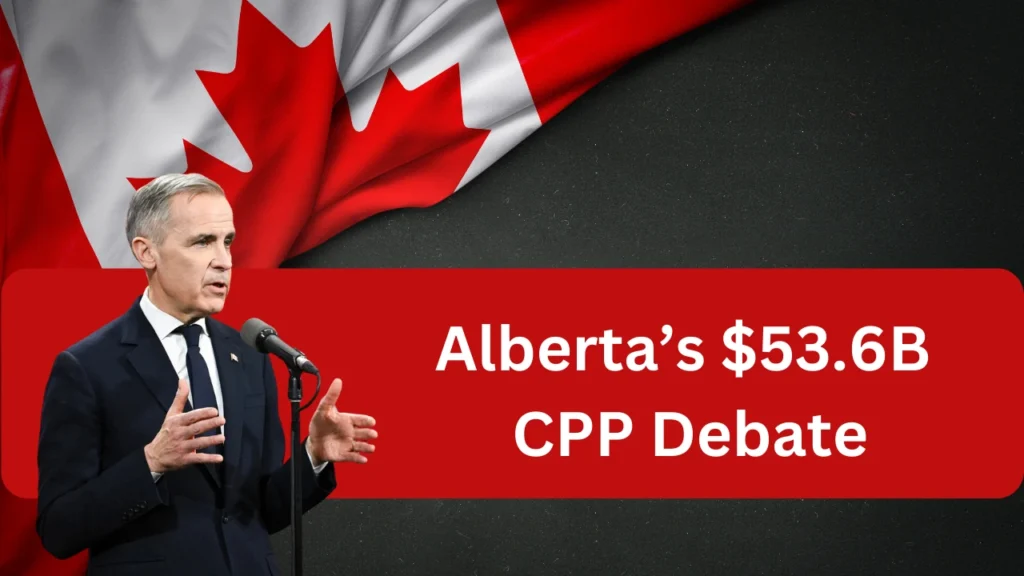Alberta’s massive $53.6 billion net contribution to the Canada Pension Plan (CPP) is making headlines across Canada. According to a new report from the Fraser Institute, Alberta has paid six times more into the CPP than the next-highest contributing province. This has sparked intense debate about whether Alberta should exit the CPP and establish its own Alberta Pension Plan (APP) — similar to Quebec’s existing pension system.
This article simplifies the issue, explains key statistics, and explores the economic, political, and financial implications of Alberta’s outsized CPP contributions.

Alberta’s CPP Contributions: The Numbers
| Metric | Value |
|---|---|
| Net CPP Contribution (1981–2022) | $53.6 Billion |
| Alberta’s Share of CPP Premiums Paid | 14.4% |
| Alberta’s Share of CPP Benefits Received | 10.0% |
| Proposed Asset Transfer if APP Proceeds | $334 Billion (est.) |
| Public Support for Alberta Pension Plan | ~22% (2023 Viewpoint) |
Why Is Alberta Contributing More to CPP Than It Receives?
1. Higher Wages
Alberta boasts some of the highest average salaries in Canada. The higher a person earns, the more CPP contributions are deducted from their paycheck.
2. Stronger Employment
Alberta’s robust job market means more residents are contributing to CPP consistently year over year.
3. Younger Demographics
With a younger population compared to provinces like Nova Scotia or Newfoundland, Alberta has fewer retirees, resulting in lower CPP payouts to the province.
What Is the Canada Pension Plan (CPP)?
The Canada Pension Plan is a mandatory, contributory public pension system. It provides retirement, disability, survivor, and death benefits to eligible Canadians, funded through employee and employer contributions.
- Employee Rate (2024): 5.95%
- Employer Rate (2024): 5.95%
- Self-Employed Rate: 11.9%
- Max Pensionable Earnings: $68,500
Everyone in Canada outside of Quebec is enrolled in CPP automatically. Quebec runs its own version, the Quebec Pension Plan (QPP).
The Case for an Alberta Pension Plan (APP)
Potential Benefits:
- Lower Contribution Rates: Alberta could offer equal or better retirement benefits at reduced payroll taxes.
- Increased Control: Alberta could manage its own investments and tailor the fund to provincial needs.
- Bigger Benefits: Some estimates suggest Albertans could receive $5,000 to $10,000 more in retirement through a customized provincial plan.
- Fair Return: More of Alberta’s contributions would benefit Alberta workers and retirees directly.
Potential Challenges:
- High Setup Costs: Launching a new pension plan would involve major legal, administrative, and operational expenses.
- Federal Negotiations: Dividing CPP assets is complex. Alberta estimates a $334 billion transfer, but federal actuaries suggest 20–25% share, not 53%.
- Market Risks: Alberta would take on full responsibility for investment performance and pension sustainability.
- Interprovincial Portability: Workers who move between provinces may face issues transferring or accessing benefits.
What Do Experts and Politicians Say?
- The Fraser Institute supports the idea, citing Alberta’s contribution gap and economic strength.
- Trevor Tombe (University of Calgary) advises caution, noting potential risks, transition costs, and market uncertainties.
- The LifeWorks Report, commissioned by the Alberta government, claims Alberta could claim over 50% of CPP assets, while Canada’s Chief Actuary disputes that.
Political Update:
The Alberta Pension Protection Act mandates a provincial referendum before any exit from CPP. Premier Danielle Smith has supported the idea of exploring APP but hasn’t yet called a vote.
What Do Albertans Think?
According to a Viewpoint Alberta poll (2023):
- 57% oppose creating a separate Alberta Pension Plan
- Only 22% support the idea
- 30% believe an APP would financially benefit the province
Public consultations and official engagement through the Alberta government’s APP Engagement Portal are ongoing.
What Happens If Alberta Leaves the CPP?
For Alberta Workers:
- Possible lower contributions with similar or better benefits
- Greater provincial control over investment decisions
For the Rest of Canada:
- Potential CPP premium increases in provinces outside Quebec
- Pressure on national pension stability without Alberta’s contributions
For Retirees:
- If Alberta exits, current retirees won’t lose benefits right away.
- A transition plan would protect earned pensions and allow gradual migration to the new APP.
Key Takeaways
- Alberta’s $53.6 billion net CPP contribution shows a clear imbalance in the federal pension system.
- Alberta is paying more into the system than it gets back — largely due to higher incomes, lower retiree counts, and strong job growth.
- The debate over leaving CPP and launching an Alberta Pension Plan is gaining momentum but also facing resistance and legal complexity.
- With a referendum required, the final decision will rest with Albertans.
FAQs: Alberta’s CPP Contributions
Why is Alberta’s CPP contribution so high?
Because of high incomes, strong employment, and a younger population — all factors that increase contributions and reduce payouts.
Can Alberta legally leave the CPP?
Yes. Like Quebec, Alberta can opt out under the Constitution, but it must follow a clear withdrawal process.
How much CPP funding could Alberta claim?
The Alberta government says $334 billion, but federal estimates suggest 20–25% of assets, not 53%.
Will leaving CPP lower my payroll deductions?
Possibly. Advocates claim APP could lower contributions while maintaining benefits, but this depends on future policies.
Will retirees lose their CPP pensions if Alberta exits?
No. Benefits already earned would be protected during the transition to APP.
Conclusion: Is an Alberta Pension Plan the Right Move?
Alberta’s long-standing position as Canada’s top net contributor to the CPP is now fueling one of the most heated financial debates in the country. The question is no longer just about money — it’s about fairness, autonomy, and the future of retirement security.
Whether Alberta should stay in the Canada Pension Plan or move toward a provincial APP depends on public opinion, economic forecasts, and political will.
Until a referendum is held, Albertans — and all Canadians — should stay informed, evaluate their retirement strategies, and participate in the ongoing discussion shaping Canada’s pension future.

